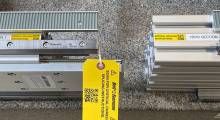You may have read that the robotics industry show is co-locating with ProMat next year in Chicago. My first reaction was: Huh! Sure, robots are very cool, and there are plenty of robots doing arc welding or loading machines on the automotive assembly line. But how often do you see robots in materials handling, especially in warehouses and distribution centers.
Turns out, there’s more than you think. In fact, according to Jeff Burnstein, president of the Robotics Industries Association (http://www.robotics.org), in Ann Arbor, materials handling is now the fastest-growing application segment for the robotics industry. “If you look at industrial robots, we’ve been dependent on automotive for years,” says Burnstein.
And, while Burnstein sees a lot of opportunity in the auto industry for his members despite the recession – growth driven by retooling for new vehicles – the growth of robots for materials handling is cutting across industries, including food, pharmaceutical and public warehousing. “There is clearly a movement to get robots into the warehouse,” he says, adding that developments like two arm robots that can work side-by-side with humans and industrial robots on mobile platforms are going to open up new opportunities for robots in the warehouse.
Certainly, our industry has seen the introduction of a number of interesting mobile robotic materials handling solutions from companies like Kiva Systems, RMT and Seegrid, along with solutions to build mixed SKU pallets from Axium and Kuka Systems/Westfalia. In fact, all five were on display at NA 2010 in Cleveland.
This past week, I’ve been talking to a number of robotic solution providers and consultants for a story on robotics for our August issue. One of the questions I’ve been asking is why now? What’s changed that is allowing robots to make the transition from the assembly line to the warehouse. I’ve heard a lot of explanations, but the one that resonates with me is that we’ve seen the cost and reliability of the technology down to where it’s competitive with the cost of labor in the warehouse and distribution center. “Robotic technology has become versatile, especially with mobile robotics that can move a pallet around a warehouse with a picker,” says Bryan Jensen, a partner with St. Onge (http://www.stonge.com). “But the most important may be that the cost of robotics is now in line with the payback, which is the cost or a portion of the cost of an operator in a distribution center.”
One of the economic hurdles to adoption of robotics in the past, Jensen adds, is that while an assembly line worker, especially in an automotive plant, was pretty highly paid, distribution labor was, frankly, cheap and available. That is changing at the same time as robotic technology is getting better and cheaper. The lines on that payback graph are finally crossing.
In other words, robotic materials handling technology is maturing and moving beyond the wow factor to a tried and true tool for materials handlers kit bag. This is going to be a very interesting area to watch over the coming years.
About the Author
Follow Robotics 24/7 on Linkedin
About the Author
Follow Robotics 24/7 on Linkedin
Article topics
Email Sign Up















